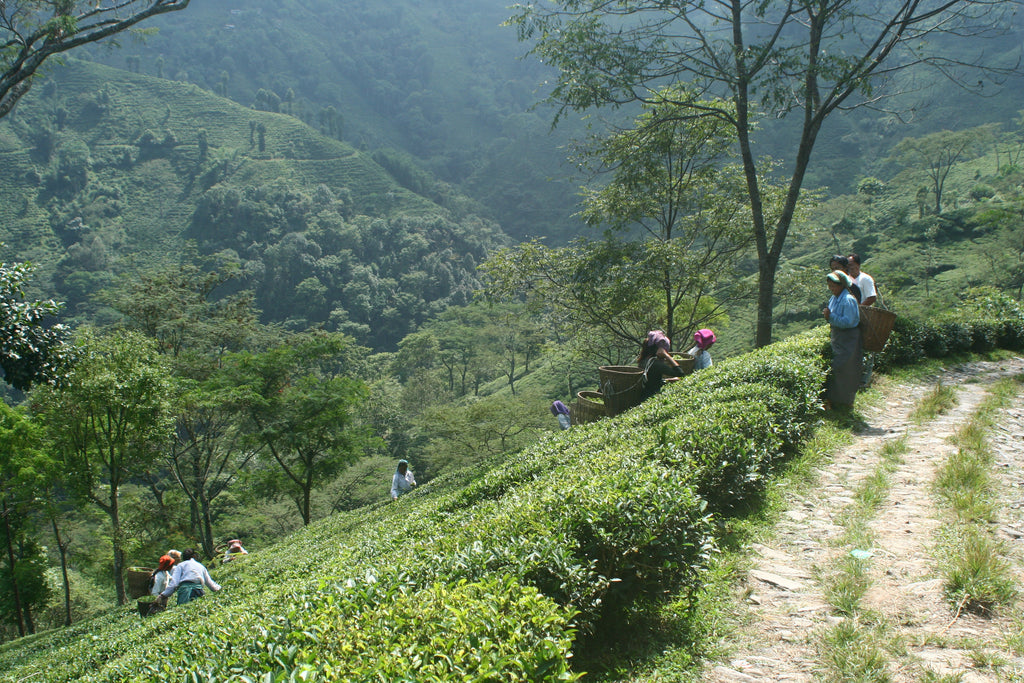Location matters for a tea garden
The quality of fine tea is dependent on many factors, with sunlight, soil content, and elevation drastically effecting the finished product. A lesser known factor, however, is the direction a hill slopes while growing tea.
I recently met with Rajesh Pareekh, a tea manufacturer who has presided over the esteemed Puttabong Tea Estate in Darjeeling for over two decades. He claims that delicate spring picked first flush teas thrive on north-facing slopes, while heartier second-flush summer teas prefer to face south-westerly.
Pareekh believes that first flush teas do better with the natural shade of the northern slopes. These hills have fewer hours of direct sunlight, causing the bushes to sprout new leaves in a process known as flushing, from which the term flush is borrowed. This technique allows the delicate flavors of a spring picked tea to emerge gently for a more complex flavor.

For the more robust second flush Darjeelings, however, direct sunlight is preferred. Therefore, tea bushes on the south-westerly slopes are better suited for summer teas, with long hours of daylight bringing out robust flavors.
Strong scientific evidence is often difficult to find in regards to tea, and the effects of slope direction for tea fields is no exception. Much of what is known of these techniques is based on "field knowledge" gained through the experience of tea planters over the years.
I met with another veteran Darjeeling tea producer, Ambar Subba, who addresses the tea slope phenomenon in his recently published "Darjeeling Tea and Darjeeling Tea Bushes." Subba explores concepts of Darjeeling tea growth both new and old in his work, and does so in my mother-tongue of Nepali, the local language of Darjeeling. Subba's family was kind enough to present me with his book during my recent travels back to Nepal.

Subba suggests that regardless of the tea flush, north-western slopes will produce the highest quality teas. Along with natural shade and a slower growing time, these slopes also attract helpful insects that benefit the tea growing process. Bugs like jassid and thrips, also known as green flies, are hugely influential to quality teas, and they are mostly found in the cooler areas of the tea garden.
While hard scientific evidence is lacking on the subject, tea planters have a myriad of speculations as to why the “infestation” of these insects can enrich the final crop. While it may seem strange that insect invasions would be desirable, many planters believe that the bugs suck moisture away from the leaves, thereby starting the withering process before harvesting begins. Some even believe this extends to the oxidation process, essentially giving the tea a head start on what would traditionally be a factory process.
When these insects “attack” the leaves, the tea plant will flood with protective chemicals, possibly contributing to the final flavor of quality bug-bitten teas. But how these chemicals, or the early onset of the oxidation and withering process, improve the quality of tea isn't clear. Creating inviting conditions to these insects also has the unique problem of attracting other, less desirable pests, such as the red spider. Unlike jassids or thrips, red spiders are highly destructive, and often require remedial measures to keep them at bay.
Despite the challenges this process poses, anecdotal evidence seems to suggest it does have some effect on the end product, as the practice of encouraging jassids and thrips to feed on the tea leaves developed in Taiwan as well. The fame of the Oriental Beauty oolong is in fact predicated on it!

Returning to the tea fields of Darjeeling, however, Subba notes another advantage enjoyed by the north-west facing slopes: because they retain more moisture due to their natural shading, they flush earlier than other teas, kicking off the year's production season. This, along with their more abundant and even yield makes the north-western slopes more desirable, while the slopes facing east and south are exposed to more drought. Assam hybrids on such slopes completely lose their leaves during the winter, hurting the spring harvest and putting more strain on the plants themselves. Further, the China bushes begin their flushing later in the season, diminishing the crucial picking period.
Researching tea can at times seem daunting, with so much to learn and so many conflicting sources. Luckily, we have experts like Rajesh Pareekh and Ambar Subba to guide us towards a better understanding of tea and its production, and if we are lucky, fine tea for us all!



